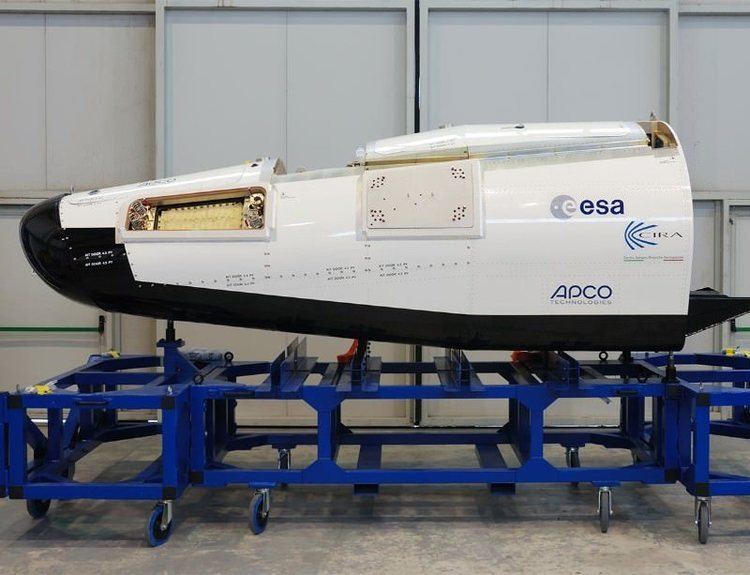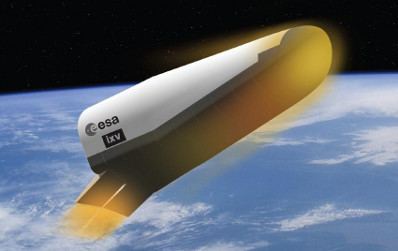Apogee 412 km (256 mi) Launch mass 1,800 kg | Max speed 27,720 km/h Launch date 11 February 2015 | |
 | ||
Website ESA Reentry technologies Recovered by recovery vessel Nos Aries Landing date February 11, 2015 (2015-02-11) Similar LISA Pathfinder, PROBA, Proba‑V, ADM‑Aeolus, Euclid | ||
The Intermediate eXperimental Vehicle (IXV) is a European Space Agency (ESA) experimental suborbital re-entry vehicle (spaceplane prototype) to validate ESA reusable launchers, evaluated in the frame of the Future Launchers Preparatory Programme (FLPP), and developed under the leadership of the NGL Prime SpA company. The IXV successfully completed its 100-minute mission on 11 February 2015 being the first ever lifting body to perform full atmospheric reentry from orbital speed
Contents
- Esa intermediate experimental vehicle ixv
- Design
- Pre launch testing
- First reentry test
- Follow up mission
- Specifications
- References

It inherited the principles of previous studies such as CNES's Pre-X and ESA's AREV (Atmospheric Reentry Experimental Vehicle), and the successful Atmospheric Reentry Demonstrator (ARD) flown in 1998. The successor of IXV will be the PRIDE spaceplane (Programme for Reusable In-orbit Demonstrator in Europe).

Esa intermediate experimental vehicle ixv
Design

IXV used a lifting body arrangement with no wings of any sort, using two movable flaps for re-entry flight control. Re-entry was accomplished in a nose-high attitude like the Space Shuttle, with manoeuvring accomplished by rolling out-of-plane and then lifting in that direction, like an aircraft. Landing was accomplished by parachutes ejected through the top of the vehicle. The airframe was based on a traditional hot-structure/cold-structure arrangement, and was supported on-orbit by a separate manoeuvring and support module similar to the Resource Module intended for the Hermes. The avionics were controlled by a LEON2-FT microprocessor, and interconnected by a MIL-STD-1553B serial bus.

On 18 December 2009, ESA announced a contract with Thales Alenia Space valued at €39,400,000 to cover 18 months of preliminary IXV work. The total estimated cost for the project is €150,000,000.
Pre-launch testing
The IXV's subsonic parachute system was tested at the Yuma Proving Ground in Arizona in late 2012. Water impact tests were conducted at Consiglio Nazionale delle Ricerche's INSEAN research tank near Rome.
On 21 June 2013 an IXV test vehicle was dropped from an altitude of 3 km (1.9 mi) in the Salto di Quirra range off Sardinia. The test was to validate the water landing system including the subsonic parachute, flotation balloons, and beacon deployment. A small anomaly was encountered when inflating the balloons, but the other systems performed as expected. After the test the vehicle was taken for further analysis.
On 23 June 2014 the recovery ship Nos Aries conducted a training exercise with an IXV test article off the coast of Tuscany.
In June 2014 the IXV test vehicle arrived at the ESTEC Technical Centre in Noordwijk, the Netherlands, to undergo a rigorous test campaign to confirm its flight readiness in anticipation of a flight on a Vega rocket in November.
First reentry test
Originally planned to make its flight in 2013, it was scheduled to perform the launch on 18 November 2014, however this initial launch window was missed due to unresolved range safety concerns. Finally the IXV was launched on 11 February 2015 by a Vega rocket as part of the VV04 mission. Spacecraft launched at 08:40 local time, separated from Vega launch vehicle at 333 km altitude and ascended to 412 km, after which it descended to begin reentry at 120 km altitude with a speed of 7.5 km/s, the same as for Low Earth Orbit spacecraft reentry. Following that IXV glided over Pacific Ocean before opening parachutes to slow down its descent, flying 7300 km from the beginning of the reentry. The ESA’s small launcher, descended to the Pacific Ocean for later recovery by the Nos Aries ship, and analysis of the spacecraft and recorded mission data.
Follow up mission
After a flawless test flight, ESA officials decided to plan an additional test flight for 2019 or 2020. This time the IXV will land on the ground instead of a splashdown by either installing a parafoil or landing gear. Planning was to begin in March 2015, with design work starting in mid 2015.
Specifications
Data from ESA, Space.com, Gunter's Space Page
General characteristics
Performance
